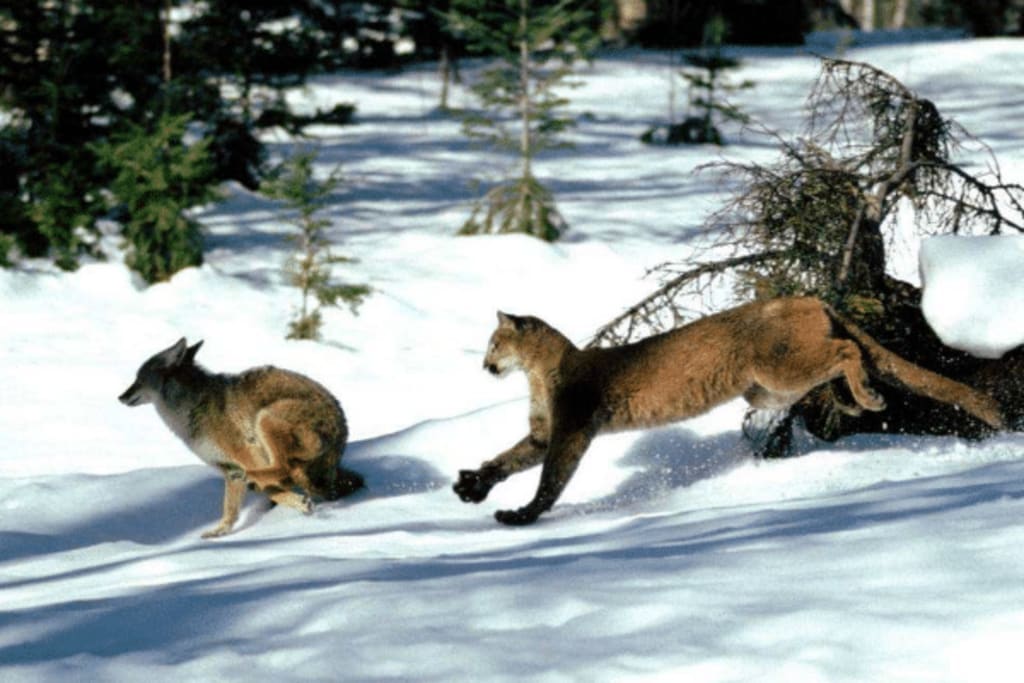
The struggle between lynxes and wolves in the Libidinal forest in Belarus is almost daily. In just 18 years, Belarusian biologists have observed 16 cases of lynx killing wolves, and 11 of them were on cubs, and the remaining 5 were specifically on pregnant females and lone wolves, and these were all observed by humans, and those kills that were not discovered by us are still We don't know how many more. Before that, Eurasian gray wolves were one of the dominant wolves in this forest, and they lived a happy life in the forest without any competition, but with the appearance of a group of lynxes, this peace was completely broken.
The face of the lynx so crazy provocation, wolves are naturally not willing to show weakness, in the encounter with the lynx will not only swarm around to intercept, but also use the advantage of the group specifically to steal their food, and retaliatory hunting lynx cubs, compressed lynx living space, so the lynx usually do not have a fixed nest, coupled with its solitary habits, often only with the children hiding. So what exactly is the reason that the lynx and the wolves are so deep in hatred for each other, and even for each other's children at any cost? In this issue, let's talk about whylynxesx and wolves are incompatible with each other. r? If the two meet, who will be better?
Speaking of lynx, probably for most people are relatively unfamiliar, with them because they are the products of the northern temperate cold region, but also the distribution of the most northern range of a feline. The lynx is the collective name of the group, and there are four species under this genus, namely the Eurasian lynx, the Ibex lynx, the Canada lynx, and the short-tailed cat, of which the Eurasian lynx has the largest number and size, and is also the lynx in our general knowledge. The Eurasian lynx is mainly distributed in Europe and northern Asia, it looks like a cat, but different from the cat is its tail is extremely short, the rabbit's tail is somewhat similar, and ear tips and a cluster of black towering hair looks very conspicuous, of course, its size is also much larger than the cat, so it is also known as the "bobcat".
As a medium-sized feline, the adult Eurasian lynx can reach a body length of 90 cm, Brigand hing about 15-30 kg, limbs and body are very sturdy, but also known as a smaller version of the "king of all animals because site temperament is more fierce than the big cats, and naturally cautious and aggressive, but also has a strong sense of revenge. Not only fierce, the lynx is also very good, it has strong limbs, is very good at climbing trees and swimming, and endurance and running speed in the feline are also outstanding, so they like to inhabit the highlands in the jungle of the intricate and chaotic, usually day and night have a certain nocturnal, mainly rabbits, squirrels, birds, rodents and other small animals for food.
However, when food is scarce, the lynx will also risk preying on some medium-sized hoofed animals, such as wild boar cubs, roe deer, , deer and some chickens, ducks and sheep, and other captive poultry, so many than the rural people, the threat of lynx to humans and poultry, more serious than large beasts. In the past, in rural areas in northern China, there are often lynxes the farmhouse scourge of poultry events, if a lynx invasion, all species of poultry hard to escape death, because the lynx's revenge psychology is stronger, even if it is not eaten to take away, it will have to bite all the poultry to exterminate, so many farmers are suffering. It is due to this character, the lynx often can not tolerate sand in the eyes, which is one of the reasons it will specialize in hunting wolf cubs.
When it comes to the relationship between lynx and wolf, it is as if they were born as a pair of long-standing enemies, because the lynx is a solitary animal with high vigilance and wariness, which makes it very sensitive to other animals, while the wolf, as a pack animal, is also bold and likes to go up to other creatures when it sees them, which is undoubtedly a threat to the lynx. This is undoubtedly a threat to the lynx. In addition, the habitat and prey of both sides overlap, and both have a strong sense of territory, so they often clash for food and territory.
In the twentieth century, a group of Eurasian lynx entered the Libidinal forest, the habitat of Eurasian gray wolves. Facing the sudden appearance of competitors, the alpha wolf, to maintain the survival of its pack, began to use its size and numerical advantage to seize the food of the lynx, and led the pack to try to expel and encircle them, trying to make them retreat. But in the face of the vengeful lynx, the head wolf's plan was wrong, because their body is too flexible and very good at climbing trees, the wolves are difficulty prevailing in the jungle, but the lynx also used the cover of the jungle and the wolves to start a guerrilla war, and a lot of revenge for killing the wolf cubs, only to make the relationship between the two sides further deteriorate.

According to the statistics of Belarusian biological experts, between the years when the lynx entered the forest, the number of their packs has increased instead of decreased, from a dozen at the beginning to 85 today, and they have also effectively curbed the development of wolf packs, and the survival rate of wolf pups has dropped from 45% to less than 10%. Because wolf pups are kept in captivity, they have fixed nests and rely on the mother wolf, and the lynx has long known their nests well to retaliate against the wolf pack. Once the mother wolf goes out to hunt, the lynx will kill the wolf pups, and even hunt the pregnant female wolf that falls alone, so it is often said that the lynx is the natural enemy of the wolf.
It is in this way that the relationship between the lynx and the wolves has gradually deteriorated and has reached the point of no common ground, so once they meet with the wolves, they will fight to the death. Then the question arises, is the lynx the natural enemy of the wolf? If the two meet on the narrow road, who will be better than the other? As we all know, the body structure of felines is very suitable for hunting, and they often have a great advantage in the case of the same size. But the adult Eurasian gray wolf is not easy to mess with, its average weight is 30-50 kg and its body length is 1-1.5 meters, which is significantly larger than the lynx in size.
But if in the forest, facing a lone wolf of comparable size, the advantage of the lynx is greater than that of the wolf, because it is more flexible and very good at sneaking and climbing trees, and the forelimbs are very well developed for controlling the opponent, plus very sharp claws, endurance and wolves are the same, so the lynx often has the upper hand in solo fights, but if faced with a huge adult North American gray wolf, the lynx I am afraid it will be difficult to resist. North American gray wolves are the largest wolves in the world, and their body length can reach two meters, and their average weight is about 70 kg, which is more than twice that of lynx, so their attacking power and biting power are also higher. As the size difference between the largest lynx and the largest wolf is too much, the lynx can only hurt it at most even if it is brave, and it is still a little difficult to subdue or kill it.
The lynx is called the natural enemy of wolves because the Eurasian gray wolves living in the Pail and Libidinal forests are not only small in size, but also limited by the local prey level and cannot be in large packs like the gray wolves in North America, and they are more often in small family-based packs. Therefore, there are often two wolves or lone wolves with cubs, which also creates unique conditions for lynxes, which often ambush pregnant females and their cubs in the jungle, and are considered natural enemies of wolves.
About the Creator
Ashmantas
Have a pet to keep you company and treat them as a companion in your busy life.






Comments
There are no comments for this story
Be the first to respond and start the conversation.